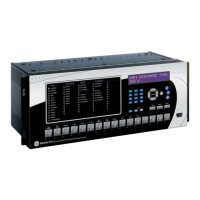9-6 C70 CAPACITOR BANK PROTECTION AND CONTROL SYSTEM – INSTRUCTION MANUAL
OVERVIEW CHAPTER 9: THEORY OF OPERATION
9
In this case, we have:
Eq. 9-18
The derivative is thus:
Eq. 9-19
Substituting equation 9-17 into equation 9-13, we have:
Eq. 9-20
Therefore:
Eq. 9-21
Substituting this value into equation 9-19, we get:
Eq. 9-22
Or alternately,
Eq. 9-23
The value can be expressed as:
Eq. 9-24
In this equation, ΔC
A
(pu) is the capacitance change as a per-unit of the leg capacitance, V
Spg
is the system phase-to-
ground voltage, and V
OP(2A)
(pu) is the operating signal resulting from the failure in the lower sub-string. Both voltages are in
per-unit of nominal bus phase-to-ground voltage, so V
Spg
can be taken as 1 when the system is normal (not faulted). Note
however that under external fault conditions sensitivity can be much different from the non-fault sensitivity.
In practice, k
A
is no less than 2.0 as the tap is no more than half way up the phase string. Comparing equation 9-16 with
equation 9-24, it can be seen that V
OP(2A)
(pu) ≥ V
OP(1A)
(pu), and thus that an element failure in the lower substring produces
a operating signal no smaller than the same failure in the upper sub-string. Thus V
OP(1A)
(pu) represents the worse case
sensitivity. A failure resulting in a 0.01 pu capacitance change in the leg capacitance results in an operating signal of at
least 0.01 pu of bus phase-to-ground voltage.

